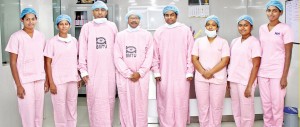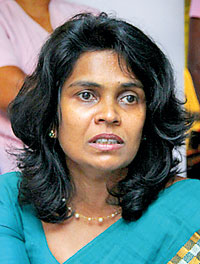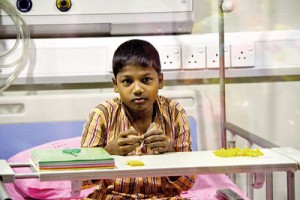Here, pink is for saving lives
View(s):A dedicated team of doctors and nurses are carrying out ground-breaking work at the state-of-the-art Bone Marrow Transplant Unit of the Nawaloka Hospital, that marks three years. Kumudini Hettiarachchi reports

The nursing team with (second from left) Dr. Wasantha Rathnayake, Prof. Lal Chandrasena, Dr. Pradeep Fernandopulle and Ms. Yshodara Rajahetti. Pix by Indika Handuwala
A posy of pink, yellow, orange and red flowers is gently offered to us by nurses clad in pink, as we bid goodbye……….all made by deft little fingers, while awaiting life-saving procedures.
Earlier, we walk around the state-of-the-art Bone Marrow Transplant (BMT) Unit of the Nawaloka Hospital in Colombo 2, having donned caps, masks and gowns once again in pink.
It is then that a peek across a dividing glass into two sterile rooms gives us a glimpse of two boys, seated cross-legged on their beds with their mothers close by, busily crafting flowers and other handicrafts. This isolation in a sterile environment sans germs such as bacteria, viruses, funguses et al is a necessity because they have undergone heavy doses of chemotherapy.
The chemotherapy is to kill off their diseased bone marrow before healthy bone marrow from a donor is infused into them, to extricate them from the vice-like grip of diseases such as thalassaemia and leukaemia.

Dr. Senani Williams
We have already met K.M. Shenon Praminda Kumara from Kumbukgahamulla in Kuliyapitiya who has successfully undergone an allogeneic haploidentical peripheral stem cell transplant for high risk Acute Lymphoblastic Leukaemia aggravated by a genetic abnormality. This transplant performed for the first time in Sri Lanka is reported to be unavailable even in many South Asian countries.
Shown around the first-floor purpose-built BMT Unit with its sophisticated equipment by Nawaloka Hospitals’ Director-General Prof. Lal Chandrasena and Consultant Oncologist Dr. Wasantha Rathnayake, we are privy to the strict protocols being practised within it.
The major successes of the BMT Unit are attributed to the multidisciplinary medical and well-trained nursing teams which work in tandem.
The medical team comprises Consultant Oncologist Dr. Rathnayake; Consultant Haematologists Dr. Senani Williams & Dr. Sasikala Suresh; Consultant Physician Dr. K.D. Duminda (Coordinator of the Programme); Consultant Transfusion Physician Dr. Lakmali Morawaka; Consultant Paediatrician Dr. Deepal Perera; Consultant Microbiologist Dr. Samanmali Gunasekera; and BMT Unit’s Coordinator Dr. Ganeshanathen Kethiswaran and Medical Officer-in-Charge Dr. Pradeep Fernandopulle.
The seven-member nursing staff is led by committed and passionate Senior Staff Nurse Yashodara Rajahetti.
The BMT Unit opened on April 7, 2014, is making preparations to celebrate its third anniversary. It comprises three large, well-equipped isolation rooms with attached bathrooms for patients; two huge refrigerators keeping all that is stored within them at
minus 40ºC and minus 80ºC respectively; an apheresis machine for the harvesting of cells and a laboratory in which the cell processing is performed.
On the doors leading to the BMT Unit, the instructions are crystal clear – ‘Authorized persons only. No visitors. Do not enter with cough, fever, sore throat or any signs of infection. No flowers.’
All precautions are taken along with bio-safety measures in the best interests of the patients, MediScene learns, for with medications to fight their own immunity and high doses of chemotherapy to kill off their diseased bone marrow before they face the transplant, any slight infection could be fatal.
With HLA (Human Leukocyte Antigen) typing a vital part of the donor-recipient match, Dr. Williams details how buccal (inside of the mouth) swabs are taken. Swabs need to be taken carefully and labelled meticulously and shipped to a laboratory in the United States of America for testing.
 The bone marrow transplants had begun in earnest after the teams had undergone extensive training in India earlier, through collaborations with the Rajiv Gandhi Cancer Research Institute and with the internationally recognized expert on thalassaemia, Dr. Lawrence Faulkner of Italy.
The bone marrow transplants had begun in earnest after the teams had undergone extensive training in India earlier, through collaborations with the Rajiv Gandhi Cancer Research Institute and with the internationally recognized expert on thalassaemia, Dr. Lawrence Faulkner of Italy.
Those who have passed through the unit and gone back to their homes across the country, in places such as Matara, Anuradhapura, Kurunegala, Welimada and Maharagama, include four who had been suffering from leukaemia between the ages of four and 15 years and 16 from thalassaemia, the youngest being just 1½ years old and the oldest 14 years.
With so much dependent on the right match, the BMT Unit also has access to two international donor registries – DKMS, the German Registry and Dathri, the Indian Registry — in case there is a need to find non-related donors for their patients.
Its patients, meanwhile, are also able to claim some part of the cost of the transplants from the President’s Fund.MediScene learns that once pre-assessment of the patient has been carried out by Dr. Rathnayake and Dr. Williams, a full-body health check is performed by Dr. Fernandopulle.
Thereafter, both the patient and his/her guardian, in most cases it is the mother, are given a sterile bath and furnished with caps, masks and gowns which have been sterilized. As the patient awaits a transplant, Dr. Fernandopulle explains that there is a “conditioning” period.
A two-port central venous line or Hickman line is fixed to the chest of the patient for easy administration of chemotherapy, drawing of blood and finally infusion of the stem cells harvested from the donor.
Ms. Rajahetti points out that there is only a positive pressure, ensured by hepa-filtres, in the rooms where the patients are kept, with outside air replete with germs not being allowed in so that they are not exposed to infection. The staff also follows a strict protocol to maintain sterility.
While the patients are awaiting the transplant, the nurses teach them handicrafts to while away the time and the beautifully crafted items including a stunning swan are displayed in the BMT Unit.
Ms. Rajahetti recalls with fondness all those who have passed through the unit, the names flowing forth without effort…….. Hirusha, the very first who was treated for Thalassaemia Major, ahinsaka but well-disciplined Himakara and Kasun, the list goes on.
And they come back regularly, from their remote village-homes bearing tiny gifts of appreciation, though not expected, the most poignant of which being some boilt bada-iringu picked from their fields, for the team which has given them hope of a new life.
| All about stem cells Before MediScene gets an introduction to the different types of bone-marrow transplants, Consultant Haematologist Dr. Senani Williams explains the three sources from which stem cells can be obtained and how it is done.The sources of stem cells (basic or primitive cells with the potential to develop into many different cell types), MediScene learns, are peripheral blood, bone marrow and cord blood.Peripheral blood is blood comprising red blood cells (erythrocytes), white blood cells (leucocytes) and platelets circulating throughout the body.Bone marrow, meanwhile, is a soft fatty substance in the cavities of bones, in which blood cells are produced, while cord blood is blood from the human umbilical cord.Referring to how peripheral stem cells are ‘harvested’ from the donor, Dr. Williams says that growth-factor stimulants are injected to stimulate the bone marrow to produce more stem cells. These cells, after a particular period of time spill over into the peripheral blood and can be collected by a special machine called an apheresis machine.In the case of bone marrow, stimulants are injected, after which the bone marrow is drawn out, she says. The final source being umbilical cord blood, stem cells are removed from a newborn’s umbilical cord soon after birth, frozen and stored until needed for a transplant. As umbilical cord blood cells are very immature, there is less of a need for ‘perfect’ matching. However, due to the smaller number of stem cells collected thus, the recipient’s blood counts take much longer to recover.The types of bone marrow transplants performed at the BMT Unit, according to Dr. Williams are: Autologous bone marrow transplant: With ‘auto’ meaning ‘self’, stem cells are removed from the patient and stored in sophisticated freezers before he/she receives high doses of chemotherapy and/or radiation. Thereafter, in this ‘rescue’ transplant, the patient’s own stems cells are put back into his/her body to make normal blood cells. (MediScene learns that some centres do not freeze the stem cells but re-infuse/introduce them within 24-36 hours after collection, soon after a high dose of chemotherapy) Allogeneic bone marrow transplant: With ‘allo’ meaning ‘other’, stem cells are removed from another person (donor) whose genes must at least partly/closely match the genes of the patient. Special tests using buccal (inside of the mouth) swabs are carried out to determine whether the donor matches the patient. Usually, a brother or a sister is most likely to be a good match, while sometimes parents, children and other relatives are also good matches. Donors who are not related to the patient, yet still match, may be found through national bone marrow registries. If a 100% match is found through a registry, it is a ‘matched unrelated transplant’. ‘Haploidentical bone marrow transplant: These are transplants where only 50% of the genes of the donor match with those of the recipient. As each parent contributes 50% of the genes to his/her child, the parents would hence be eligible to be a haploidentical donor, as in the case of Shenon and his father. | |
| Bone marrow transplants answer to many diseasesNawaloka Hospital’s BMT Unit is currently offering bone marrow transplants for: Haemoglobinopathy — Beta Thalassaemia Major Leukaemia — Acute Lymphoblastic Leukaemia (ALL) & Acute Myeloblastic Leukaemia (AML)Multiple Myeloma There is a range of other diseases too for which bone marrow transplants are the answer: Haematological diseases such as haemoglobinopathies including Sickle Cell Disease (SCD). Leukaemias and lymphomas such as Chronic Myeloid Leukaemia (CML); Juvenile Myelomonocytic Leukaemia; Hodgkin Lymphoma and Non-Hodgkin Lymphoma (NHL).Bone marrow diseases and other diseases when bone marrow fails such as Severe Aplastic Anemia; Fanconi Anemia; Paroxysmal Nocturnal Hemoglobinuria (PNH); Pure Red Cell Aplasia; and Amegakaryocytosis/congenital thrombocytopenia. Inherited metabolic disorders such as Hurler Syndrome (MPS-IH); Metachromatic Leukodystrophy (MLD); Krabbe Disease (GLD); Adrenoleukodystrophy (ALD); and Gaucher Disease.Inherited immune system disorders such as Severe Combined Immunodeficiency (SCID, all types) Syndrome and Wiskott-Aldrich Syndrome (WAS).Multiple myeloma and other plasma cell disorders; Myelodysplastic syndromes & myeloproliferative disorders; Familial erythrophagocytic lymphohistiocytosis & other histiocytic disorders; and certain other malignancies or cancers. |


